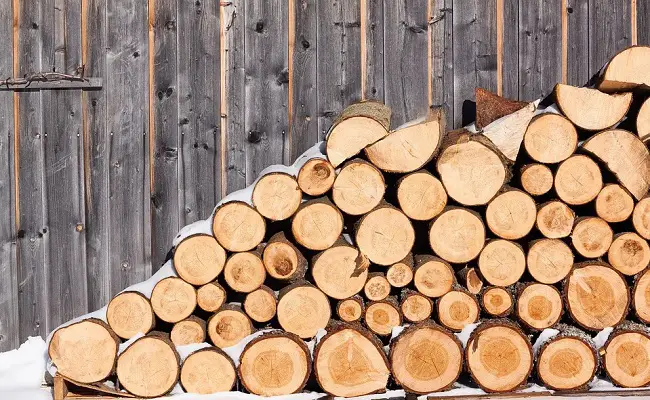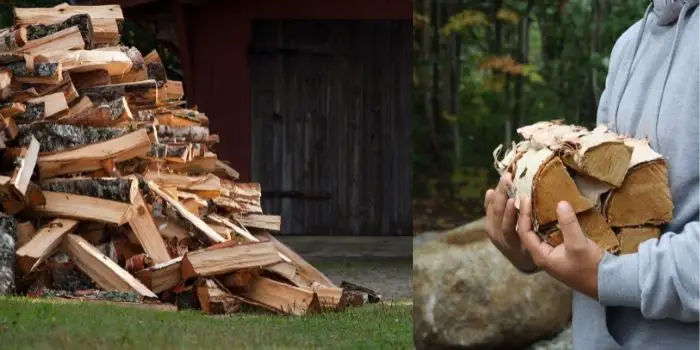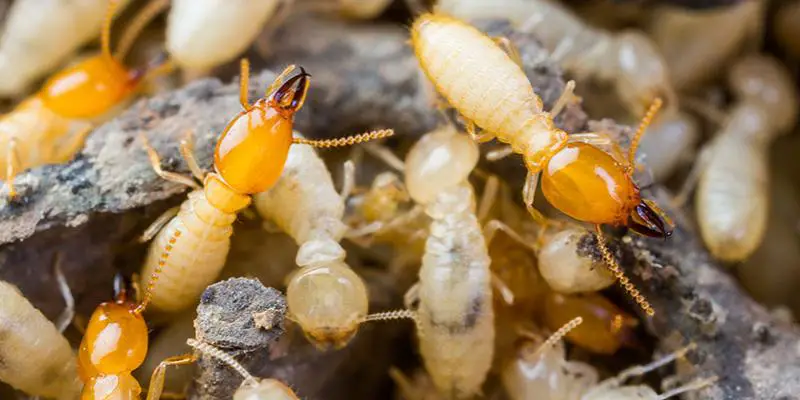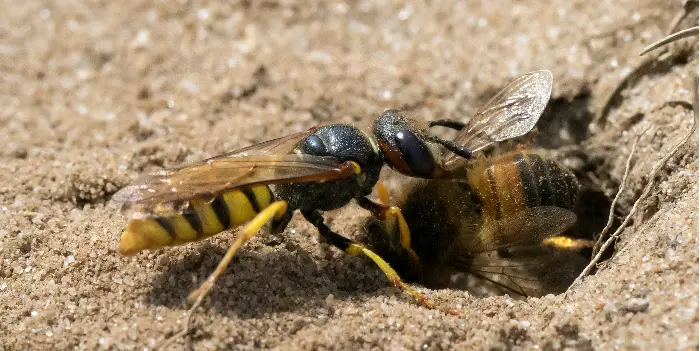
If you do keep the firewood stacked outside the home or in a store, there are two insects and three types of beetles that you need to be concerned about.
They may be present to feed on the cellulose of the firewood, plus to find a safe place to live and thrive in.
And while they do not present a danger to those living inside, they can be annoying, and some may damage your home.
In this article, we will take a look at some of these most common firewood bugs and ways how to keep them away.
So, let’s get started with our list.
What Insects Live in Wood Piles?
A few reasons why your woodpile may be appealing to the bugs are:
- It remains undisturbed by humans for long
- It provides nooks and crannies for bugs to hide
- It’s resistant to wind, rain, snow, and natural predators
Some of the most common bugs that may be present in the stored wooden logs include…
1- Bark Beetles
Perhaps the most familiar of all beetles, the bark beetle is often found around dead or dying trees.
They tend to be small, cylindrical in shape, and black or brown in coloring.
You will often find several bark beetles chewing on wood, including your firewood.
A single log from a tree may contain hundreds of these beetles.
2- Longhorn Beetles
The name comes from the longhorn-like antennae that are often longer than the beetle’s body.
They will often have yellow stripes on their bodies and be from a half-inch to one and a half-inch in length.
You’ll find longhorn beetles around freshly cut wood, trees that have recently been cut down, or trees that are dying.
The females will lay their eggs in the bark of the wood.
The larvae they produce will spend the next one to three years tunneling through the wood just under the bark.
If you see sawdust in trails on the wood, that is a good sign it has longhorn beetle larvae inside.
If you see holes on top of the wood with sawdust around it, that is when the larva have become adults and emerged.
In their larvae stage, they are like worms with brown heads and rounded wrinkled bodies.
3- Metallic Wood-Boring Beetles
Because of their bullet shape and metallic sheen, they are called metallic wood-boring beetles.
The larvae have a large, flat head that gives them the name flathead borers.
The larvae are born inside the wood, and when they become adults will emerge and search to find more food.
They present no danger in the home but can be annoying to some homeowners.
If you find wood that has been extensively tunneled, then it might not be worth bringing inside at all.
You should check to ensure that the wood is in good condition. If not, then burning it outside may be in order.
4- Carpenter Ants
Carpenter ants will not feed on the firewood but instead use it as a place to nest.
They tend to hollow out the inside of the firewood material to create rooms to raise their young.
You may see the galleries they create that often go with the grain of the wood because that is easier for them to burrow.
If you bring firewood infested with carpenter ants inside your home, they may decide to move out and take up residence.
This assumes that they can warm up enough to get out before you put the wood into the fire.
However, it is only a small chance that the ants will survive for very long inside your home.
Having said that, if the weather warms up enough, the carpenter ants inside the firewood may find a way into your home from the outside.
5- Termites
Termites love to consume wood.
This means that any wood left on the ground will attract termites.
You can see their presence through the mud tunnels they create to get to the wood and what might be on it.
The queen will probably be in a nest in the ground, but the workers will tunnel to the firewood for food.
Because your home is not a suitable nesting ground for termites, they will not be able to establish a new nest.
Plus, they are probably not strong enough to damage your home’s furniture or wood structure.
However, if the firewood or pallets is stacked outside, then they may be able to find a way into your home and feed on the wood that is consumable for them.
As you might have guessed, the best way to prevent the termites from feeding on the firewood when it is stacked outside is to keep it off the ground.
If you see termites near your home, you’ll want a pest control specialist to treat the area and destroy the nest.

How to Get Rid of These Bugs in Firewood?
If the conditions outside are cold, the insects may still be in a state of hibernation or simply unable to move until they warm up.
That’s good news as the firewood can be used without concern for the insects leaving the wood.
But be advised that using insecticides will have little effect since the insects are probably too deep to feel the effects.
And what is worse, the residue of the insecticide burning off the reclaimed wood will only present a health hazard to you and those living inside.
So, in order to keep the bugs away from your woodpile, you can consider trying the following strategies that can work safely…
1- Keep your woodpile dry
To keep the wood bug-free, you must keep it from getting humid or wet.
Moisturised wood becomes weak and fragile, attracting more insects because they can easily penetrate, burrow, and eat through.
To keep the wood dry, keep it protected from rainwater, snow, and storm.
Check for the nearby drains or water puddles. If there are any leakages, fix them as that can cause problems.
2- Keep the firewood far from your home
Do NOT store the firewood inside your home, basement, attic, storage, garage, or spare room.
If you want to prevent any insects from coming into your home, then it is best to keep all the reclaimed firewood outside until it is ready to be burned.
It’s best to keep them in a backyard at least 30 feet from your house’s exterior walls.
That way, you minimize the invasion of the insects that might decide the inside of your home is better than the firewood.
3- Keep the wood secured off the floor
This simply means you should be tarping your firewood completely before storing it.
Plus, you should not allow your woodpile to touch the floor as it will make it easier for insects to drift on them via flooring.
It’s good to layer up the pile on a surface like concrete bricks or mud at the bottom.
For extra protection, use a bug repellent spray before you put the wood on the surface.
Also, ensure you keep them organized in a clean, tidy, and secure manner.
4- Rotate the woodpile and practice FIFO
FIFO stands for “First-In, First-Out.”
This simply means that when it’s time for you to restock, always rotate the wood so that the older logs will be used first and the newer logs later.
Bringing in and burning the older woodpile first will help in getting rid of the bugs colonies that may already be present there.
These nesting insects may otherwise affect the newer bug-free lumber – if not rotated.
Also, when you bring the older woodpile inside your home for burning, use them asap.
Do not let them sit around your living room for days as they can have the eggs of insects or spider webs that can be unhygienic and harmful.
5- Check your firewood regularly and buy from only reliable sources
When you store, perform regular checks and look for bugs that may be thriving inside the firewood.
With a torch, inspect and closely examine the wood for any nests or the droppings of the pests that may be nearby.
Also, when it’s time to buy a fresh stock of wood for the coming season, consider buying them only from local sources whom you know and trust.
Buying cheaper firewood or imported wood from unknown sellers might save you a few bucks but can prove to be expensive if you need to deal with the bugs that may be present inside.

What Can Kill the Bugs in Reclaimed Wood?
If you have bugs in your reclaimed woodpile or decorative wood logs, killing them inside can also be a great solution.
Here are some effective methods you can try…
1- Freeze the wood
Freezing the wood will kill off most of the bugs present in it if you do it right.
- Wrap an entire wood log with a cloth and place it into a commercial freezer or an ice chest
- Keep it there for at least 3 days and then take it out to thaw the piece
- Check for any bug activity – most probably, you will not find the live bugs there
For this method, do not use your fridge in the kitchen as the bugs present may contaminate the food.
Also, note that there can be specific insects or mosquitoes present that may be tolerant to colder temperatures.
So, the freezing of wood may not work for killing all kinds of bugs.
If you find the bugs still present, you will need to consider using other methods like heating or disposing of the entire woodpile.
2- Bake the firewood
Temperatures above 130°F (around 55°C) can kill most insects in the wood.
So, if you heat your firewood to such a temperature for several hours, you can eliminate most pests.
Keep in mind that wood is thick, insulated material that takes time to heat. And your goal is to heat the inside of the wood and not burn it from the outside.
So, the best solution is to bake the bug-infested wood in the oven for a few hours.
You can keep the multiple wood pieces at a time if your oven is large enough to accommodate them.
But listen, it may take up to 5 to 7 hours (or even more) to kill and eliminate the bugs 100%.
And in the process, you will need to be extra cautious as the wood can burn inside the oven.
Also, the bugs can fly off the wood and can stick to the sides of the microwave oven, which you will need to clean and disinfect afterward.
Just in case you do not want to contaminate your oven or want to avoid the risk of burning, you may consider overheating the wood logs in the sun for a few days instead of putting them in an oven.
3- Fumigate the firewood
If there is moisture in the firewood or somewhere between the logs (maybe due to the rain), mosquitoes, woodworms and spiders can thrive there.
They can even lay their eggs to hatch larvae in the old firewood pile.
In such scenarios, fumigating the firewood can be a viable option if you find the insect infestation is out of control.
To fumigate the firewood, you can use borate mixes or sprays available on the market. This will penetrate deep into the wood to kill the insects and their larvae.
Make sure you follow the manufacturer’s directions carefully while using such products.
Also, note that most reclaimed wood cannot be burned after you have fumigated it. If you do so, it can release dangerous compounds into the air.
Considering this, it may be easier to just dispose of the firewood safely and buy a new pile.
Final Thoughts
When the firewood you cut is brought into the home, it may have some unexpected guests.
These are the arthropods and insects that like to live in your firewood.
In most cases, the insects that are present do not pose any danger to you, your pets, your furniture, or the structure of your home.
They are simply there to feed off the firewood or use it to shelter against the elements.
So, before you try to use harmful chemicals such as insecticides to get rid of these firewood bigs, think again.
Choose the options that are right for your family and can keep them safe.
Share the post "5 Bugs That Lives in Firewood – How to Keep Them Off?"

Welcome to ProShieldPest.com. I am Tina Jones. I have been working as a pest removal professional in Winslow, Arizona lately. At present, I love to spend my time with my family as a retiree.
Here I share all my knowledge and experiences to help people understand better how they can stop pests at their homes without actually killing them. Hopefully, the information you will find here will help in safeguarding your home! You can check more about me here.




